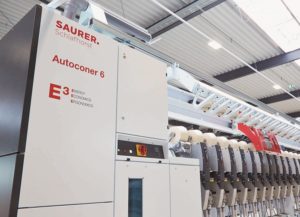 The 2.5-millionth Autoconer winding unit was put into operation in 2017. The history of the Autoconer is characterised by a long list of ground-breaking inventions that have always increased customer benefits.
The 2.5-millionth Autoconer winding unit was put into operation in 2017. The history of the Autoconer is characterised by a long list of ground-breaking inventions that have always increased customer benefits.
Autoconer 107, the first product generation of the Autoconer, radically changed workflows in the package winding sector. Autoconer 138: the invention of splicing technology, it astounded the textile world in 1976 with its separate mechanical, electric and pneumatic functions and in 1978, the innovative splicer mechanism revolutionised yarn joining: the splice replaced knots for the first time. In 1987, Schlafhorst brought the Autoconer 238 onto the market, the first winding machine with single winding unit drive. This led to increased flexibility and quality in the spinning mills. The Autoconer 338, with new drives and sensors went into production in 1997, while the starting pistol also sounded for the development of intelligent FX technologies. Autotense FX, the first online yarn tension control, is still the undisputed industry benchmark today. In 2007, Schlafhorst introduced the textile industry to the world of digital yarn displacement for processing bobbins. The Autoconer 5 revolutionised the production of process-optimized packages with its drumless yarn displacement system PreciFX. Two years later Schlafhorst was once again at the cutting edge of the automatization trend with the Autoconer X5.
Autoconer 6 (in the picture) – self-optimising and E³ certified came in 2015. With the Autoconer 6, Schlafhorst presented an automatic package winder with self-optimised process cycles. It is E³ certified because it gives spinning mills the world over threefold added value in the fields of energy, economics and ergonomics.
The first Autoconer generations were primarily sold in Europe and North America where the demand for automation of the textile industry was already quite advanced. Today, the strongest key markets are in Asia.




